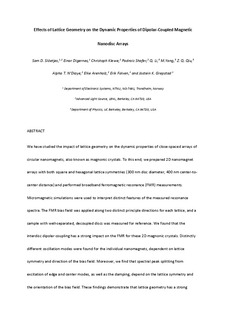Effects of lattice geometry on the dynamic properties of dipolar-coupled magnetic nanodisk arrays
Slöetjes, Samuel Dingeman; Digernes, Einar; Klewe, Christoph; Shafer, Padraic; Li, Qian; Yang, M.; Qiu, Z.Q.; N'diaye, Alpha T; Arenholz, Elke; Folven, Erik; Grepstad, Jostein
Journal article, Peer reviewed
Accepted version
Permanent lenke
http://hdl.handle.net/11250/2638589Utgivelsesdato
2019Metadata
Vis full innførselSamlinger
Sammendrag
We have studied the impact of lattice geometry on the dynamic properties of close-spaced arrays of circular nanomagnets, also known as magnonic crystals. To this end, we prepared 2D nanomagnet arrays with both square and hexagonal lattice symmetries (300-nm disk diameter, 400-nm center-to-center distance) and performed broadband ferromagnetic resonance (FMR) measurements. Micromagnetic simulations were used to interpret distinct features of the measured resonance spectra. The FMR bias field was applied along two distinct principal directions for each lattice, and a sample with well-separated, decoupled disks was measured for reference. We found that the interdisk dipolar coupling has a strong impact on the FMR for these 2D magnonic crystals. Distinctly different oscillation modes were found for the individual nanomagnets, dependent on lattice symmetry and direction of the bias field. Moreover, we find that spectral peak splitting from excitation of edge and center modes, as well as the damping, depends on the lattice symmetry and the orientation of the bias field. These findings demonstrate that lattice geometry has a strong influence on the excited spin-wave spectrum and is a relevant design parameter for spintronic devices.
